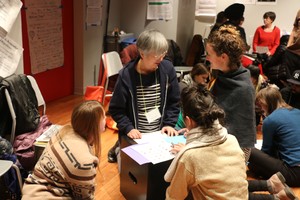Wrapping up several weeks of our Teaching Artist Training & Internship Program (TATIP) workshop training has shown how rich and dense the Community-Word Project training really is. This past Saturday, December 10th, we closed with some new thoughts and resources on classroom management. We also took the time to reflect on our graffiti walls and have some of the questions from our question gardens answered. It was at this point that I realized just how much we covered in such a short span of time (6 weeks). Classroom management and scaffolding alone can take several weeks. The beauty of the program, however, was that it interwove and gradually introduced and exemplified these processes during the course of the training.
Patti Chilsen, Karla Robinson, Heidi Miller, and Scott Lilly subtly, through the teaching of the workshop, demonstrated this. They asked us questions about our observations, in respects to how they introduced subject matter to us. They made us think and analyze their presentation of topics and activities. By actively engaging, they demonstrated how important experiential learning is and showed us how important it is to give our students agency. This is how students build trust within themselves, and with their instructors as well.

In exemplifying their teaching structure and path, they also helped us to see the efficacy of their teaching styles. They emphasized that although there may be various styles that are acceptable and affective, this was the way in which they found it to be beneficial for us. They gave us words of encouragement and let us know that it is okay to make mistakes and do things differently than what others do. Also, if we lacked the time to finish out certain activities, they let us know that it was okay to circle back to it at our own time, letting us know that the process is perpetual and readily available to us at all times. Time management was a crucial lesson for all of us, especially when designing our own lesson plans.
We learned that less is more and sometimes, in order to scaffold appropriately, we must peel back a bit from the layers of our activities and subject matter. This is important because our students should sit and simmer in the richness of the well-thought and planned aspects of what we introduce to them. With this, comes the significance of age-appropriate lesson planning. We need to make sure we do not overwhelm younger children with activities that would be more appropriate for an older audience, and we also need to make sure our older students are challenged and given more agency. This retains our student audience better, allowing for interest and undivided attention. This attention, in turn, benefits our students and enriches their lives. They are able to walk away with more because we are able to provide them with more. We would not be able to offer them this had it not been for the thoughtful planning and execution of our instructor’s teaching paths for us.



